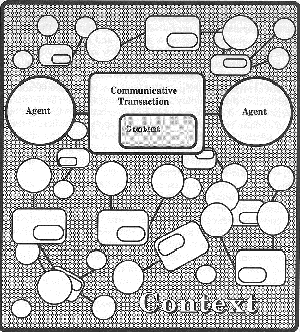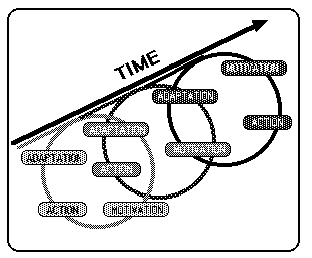Hypermedia Online Publishing: the Transformation of the Scholarly Journal
2.2.4 An ecology of communicative transactions
These concepts, axioms and theorems play themselves out within an over-arching framework, that of the ecology of communicative transactions as represented in figure 2-1.
|
|
Kaufer and Carley argue that communicative transactions, agents, content and context fit into a single ecology of communication. Ecology evokes images of richness, interdependence, and evolving complexity. All of these, Kaufer and Carley argue, are characteristics of the ecology of communicative transactions. Their constructural framework is grounded on the assumptions already listed and built on its concepts. The two most useful features of their model for this thesis are the idea of an open systems ecology, and the communicative transaction.
Open systems ecology
In a traditional open systems model, an agent is viewed in terms of the inputs into, and outputs from, an agent process. The process is only important because of the way in which it transforms the inputs into outputs. Applying an open system approach to communication "emphasizes the agent, the context (environment), and the content of the transactions (inputs and outputs)" [Kaufer&Carley1993, p. 95]. The idea of the ecological constructural framework is to build on this simple model by regarding all these components of communication as "mutually defining, coadaptive, and coevolving components of single ecology" [Kaufer&Carley1993, p. 95]. The critical terms here are coadaptive and coevolving. In the context of research into new forms of communication, such a model means that attempting to consider any one component in isolation is fraught with difficulties. Changes in one area will almost certainly prompt unpredictable changes in another. One is reminded of the butterfly beloved of chaos theory that by flapping its wings in the Amazon causes a cyclone in Texas.
Communicative transactions
Kaufer and Carley describe the communicative transaction as a cyclic process of interaction, communication and adaptation between individuals (shown in figure 2-2). Within each cycle, individuals pass through the phases of motivation (the decision making that decides on an interaction partner), action (the communication of information to that partner), and adaptation (updating one's state of knowledge in the light of the information that has been communicated). These phases do not need to occur sequentially or even in any particular order. Over time, the cycles repeat. In contrast to some theories of communication, any of these phases can drive the communicative transaction.
Last modified: Monday, 11-Dec-2017 14:41:46 AEDT
© Andrew Treloar, 2001. * http://andrew.treloar.net/ * andrew.treloar@gmail.com

